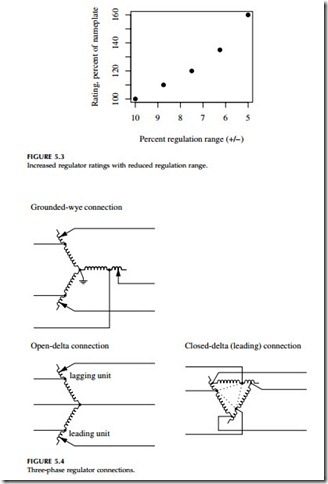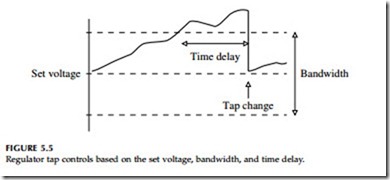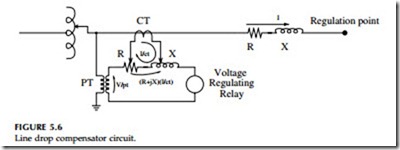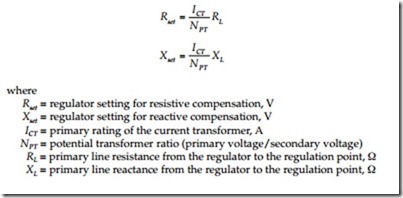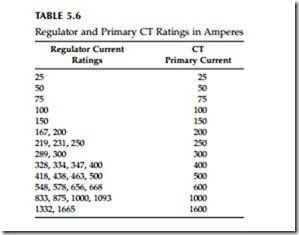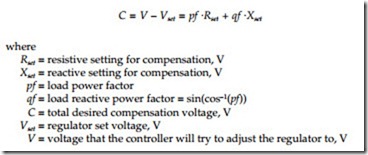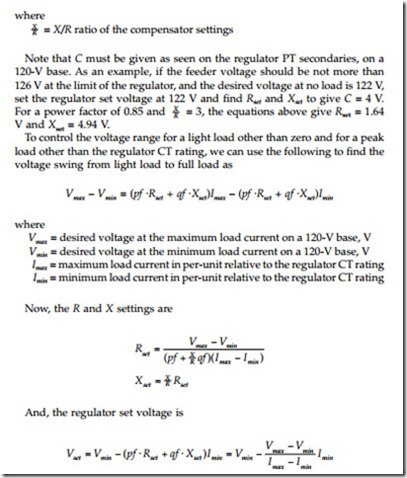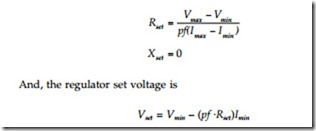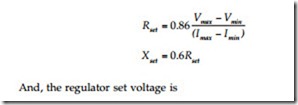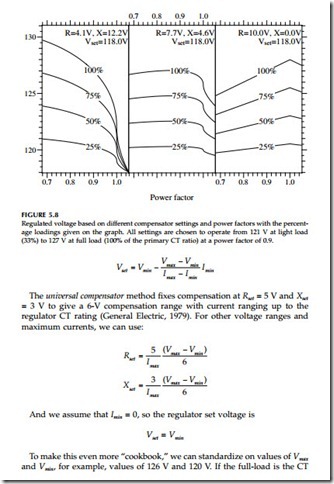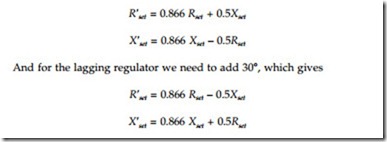Regulators
Voltage regulators are autotransformers with automatically adjusting taps. Commonly, regulators provide a range from –10 to +10% with 32 steps. Each step is 5/8%, which is 0.75 V on a 120-V scale.
A single-phase regulator has three bushings: the source (S), the load (L), and the source-load (SL). The series winding is between S and L. Figure 5.2 shows a straight regulator (ANSI type A) with the taps on the load side. An ANSI type B, the inverted design, has the taps on the source bushing. The regulator controller measures current with a CT at the L bushing and mea- sures the voltage with a PT between L and SL. Regulators have a reversing switch that can flip the series winding around to change back and forth between the boost and the buck connection.
Regulators are rated on current (IEEE Std. C57.15-1999). Regulators also have a kVA rating which is the two-winding transformer rating and not the load-carrying capability. A regulator at 7.62 kV line to ground with a ±10% range and a load current rating of 100 A has a kVA rating of 0.1(7.62 kV)(100A) = 76 kVA. The load-carrying capability is ten times the regulator’s kVA rating.
By reducing the range of regulation, we can extend the rating of the regulator. Reducing the range from ±10 to ±5% increases the rating by 60% (see Figure 5.3).
The impedance is the two-winding impedance times a base value about ten times as large. Because the impedance is so small, we can normally neglect it.
Three-phase regulators, often used in stations, are used on wye or delta systems. A three-phase regulator controls all three phases simultaneously. These are normally larger units. The normal connection internally is a wye connection with the neutral point floating.
Commonly, utilities use single-phase units, even for regulating three-phase circuits. We can connect single-phase regulators in several ways [see Figure and (Bishop et al., 1996)]:
• Line to neutral — On four-wire systems, three-phase circuits normally have three single-phase regulators connected line to neutral. Line- to-neutral connections are also appropriate for single-phase and two- phase circuits. Each regulator independently controls voltage, which helps control voltage unbalance as well as steady-state voltage.
• Open delta — Only two single-phase regulators are needed, each connected phase to phase.
• Closed delta — Three regulators are connected phase to phase. Using the closed delta extends the regulation range by 50%, from ±10 to ±15%.
In both of the delta connections, the regulators see a current phase-shifted relative to the voltage. In the leading connection with unity power factor loads, the line current through the regulator leads the line-to-line voltage by 30°. The lagging connection has the current reversed: for a unit power factor load, the line current lags the line-to-line voltage by 30°. In the open-delta configuration, one of the units is leading and the other is lagging. In the closed-delta arrangement, all three units are either leading or all three are lagging. Although uncommon, both of the delta connections can be applied on four-wire systems.
Regulators have a voltage regulating relay that controls tap changes. This relay has three basic settings that control tap changes (see Figure 5.5):
• Set voltage — Also called the set point or bandcenter, the set voltage is the desired output of the regulator.
• Bandwidth — Voltage regulator controls monitor the difference between the measured voltage and the set voltage. Only when the difference exceeds one half of the bandwidth will a tap change start. Use a bandwidth of at least two times the step size, 1.5 V for ±10%, 32-step regulators. Settings of 2 and 2.5 V are common.
• Time delay — This is the waiting time between the time when the voltage goes out of band and when the controller initiates a tap
change. Longer time delays reduce the number of tap changes. Typ- ical time delays are 30 to 60 sec.
If the voltage is still out of bounds after a tap change, the controller makes additional tap changes until the voltage is brought within bounds. The exact details vary by controller, and some provide programmable modes. In some modes, controllers make one tap change at a time. In other modes, the controller may initiate the number of tap changes it estimates are needed to bring the voltage back within bounds. The time delay relay resets if the voltage is within bounds for a certain amount of time.
A larger bandwidth reduces the number of tap changes, but at a cost. With larger bandwidth, the circuit is not as tightly regulated. We should include the bandwidth in voltage profile calculations to ensure that customers are not given over or under voltages. Voltage that was used for bandwidth can be used for voltage drop along the circuit. With a higher bandwidth we may need more regulators on a given line. So, use at least two times the step size, but do not use excessively high bandwidths such as 3 or 3.5 V.
In addition to these basics, regulator controllers also have line-drop compensation to boost voltages more during heavy load. Controllers also may have high and low voltage limits to prevent regulation outside of a desired range of voltages. In addition to the regulator and control application information provided here, see Beckwith (1998), Cooper Power Systems (1978), General Electric (1979), and Westinghouse (1965).
Many regulators are bi-directional units; they can regulate in either direction, depending on the direction of power flow. A bi-directional regulator measures voltage on the source side using an extra PT or derives an estimate from the current. If the regulator senses reverse power flow, it switches to regulating the side that is normally the source side. We need reverse mode for a regulator on circuits that could be fed by an alternate source in the reverse direction. Without a reverse mode, the regulator can cause voltage problems during backfeeds. If a unidirectional regulator is fed “backwards,” the regulator PT is now on the side of the source. Now, if the voltage drops, the regulator initiates a tap raise. However, the voltage the PT sees does not change because it is on the source side (very stiff). What happened was the voltage on the load side went down (but the regulator controller does not know that because it is not measuring that side). The controller still sees low voltage, so it initiates another tap raise which again lowers the voltage on the other side of the regulator. The controller keeps trying to raise the voltage until it reaches the end of its regulation range. So, we have an already low voltage that got dropped by an extra 10% by the unidirectional regulator. If the controller initially sees a voltage above its set voltage, it ratchets all the way to the high end causing a 10% overvoltage. Also, if the incoming voltage varies above and below the bandwidth, the regulator can run back and forth between extremes. A bi-directional regulator prevents these run- aways. Depending on its mode, under reverse power, a bi-directional reg- ulator can regulate in the reverse direction, halt tap changes, or move to the neutral point (these last two do not require PTs on both sides but just power direction sensing).
Regulators also have an operations counter. The counter helps identify when a regulator is due for refurbishment. Regulators are designed to per- form many tap changes, often over one million tap changes over the life of a regulator. A regulator might change taps 70 times per day, which is 25,000 times per year (Sen and Larson, 1994). A regulator counter also provides a good warning indicator; excessive operations suggest that something is wrong, such as wrong line drop compensation settings, a bandwidth or time delay that is too small, or widely fluctuating primary voltages.
Regulators have “drag hands” — markers on the tap position indicator that show the maximum and minimum tap positions since the drag hands were last reset. The drag hands are good indicators of voltage problems. If maintenance reviews continually show the drag upper hand pegging out at +10%, the upstream voltage is probably too low. More work is needed to correct the circuit’s voltage profile. Advanced controllers record much more information, including tap change records and demand metering to profile voltages, currents, and power factors.
Line-Drop Compensation
LTC transformer and regulator controls can be augmented with line-drop compensation. During heavy load, the controller boosts voltage the most, and during light load, voltage is boosted the least. The line-drop compen- sator uses an internal model of the impedance of the distribution line to match the line impedance. The user can set the R and X values in the compensator to adjust the compensation. The controller adjusts taps based on the voltage at the voltage regulating relay, which is the PT voltage plus the voltage across the line-drop compensator circuit (see Figure 5.6). With no compensation, the voltage regulating relay adjusts the taps based on the PT voltage.
Since load on a typical distribution line is distributed, R and X compen- sator settings are chosen so that the maximum desired boost is obtained
under heavy load while a given voltage is obtained under light load. There are two main approaches for selecting settings:
• Load center — The settings are chosen to regulate the voltage at a given point downstream of the regulator.
• Voltage spread — The R and X settings are chosen to keep the voltage within a chosen band when operating from light load to full load. The R and X settings may or may not be proportional to the line’s R and X.
The main complication of all of the methods is that the load and power factors change (especially with downstream capacitor banks). Many regula- tors are set up without line drop compensation. It is obviously easier and less prone to mistakes, but we are losing out on some significant capability. If we set the regulator set voltage at 120 V, and we do not get enough boost along the line, we will need more regulators. With a higher set voltage such as 126 V, we do not need as many regulators, but we have high voltages at light load and possibly overvoltages if the circuit has capacitors. With line drop compensation, we have boost when we need it during heavy load, but not during light load (see Figure 5.7). Line-drop compensation also normally leads to a smaller range of fluctuations in voltage through the day for customers along the circuit.
Load-Center Compensation
The classic way to set compensator settings is to use the load-center method. Consider a line with impedances RL and XL with a load at the end. Now, if we pick the Rset and Xset of the compensator to match those of the line, as the load changes the regulator responds and adjusts the regulator taps to keep the voltage constant, not at the regulator but at the load. To achieve this, we can set the Rset and Xset of the regulator as
A regulator’s R and X compensator settings are in units of volts. By using volts as units, we can directly see the impact of the regulator on a 120-V scale. Consider an example where the set voltage is 120 V. With a current at unity power factor and Rset = 6 V (Xset does not matter at unity power factor), the controller regulates the voltage to 120 + 6 = 126 V when the current is at the peak CT rating. If the current is at half of the CT rating, the controller regulates to the set voltage plus 3 or 123 V. Available compensator settings are normally from –24 to +24 V.
Note that the primary CT rating is an important part of the conversion to compensator settings. The CT rating may be the same as the regulator rating or it may be higher. The CT rating is given on the nameplate. Table 5.6 shows the regulator ratings and primary CT current rating for one manufacturer. Regulators may be applied where the nameplate voltage does not match the system voltage if they are close enough to still allow the desired regulation range at the given location. Also, some regulators have taps that allow them to be used at several voltages. Make sure to use the appropriate PT ratio for the tap setting selected.
When specifying impedances for the line-drop compensator, use the cor- rect line impedances. For a three-phase circuit, use the positive-sequence impedance. For a single-phase line, use the loop impedance ZS which is about twice the positive-sequence impedance.
On a delta regulator, either an open delta or a closed delta, divide the PT ratio by
3 . On a delta regulator the PT connects from phase to phase, but the internal circuit model of the line-drop compensator is phase to ground, so we need the 3 factor to correct the voltage.
Line-drop compensation works perfectly for one load at the end of a line, but how do we set it for loads distributed along a line? If loads are uniformly distributed along a circuit that has uniform impedance, we can hold the voltage constant at the midpoint of the section by using:
• 3/8 rule — For a uniformly distributed load, a regulator can hold the voltage constant at the midpoint of the circuit if we use line-drop compensation settings based on 3/8 of the total line impedance. A circuit with a uniformly distributed load has a voltage drop to the end of the circuit of one half of the drop had all of the loads been lumped into one load at the end of the circuit. Three-fourths of this drop is on the first half of the circuit, so (1/2)(3/4) = 3/8 is the equivalent voltage drop on a uniformly distributed load.
Make sure not to allow excessive voltages. We can only safely compensate a certain amount, and we will have overvoltages just downstream of the regulator if we compensate too much. Check the voltage to the voltage regulating relay to ensure that it is not over limits. The maximum voltage is
If V is more than what you desired, reduce Rset and Xset appropriately to meet your desired limit.
Voltage-Spread Compensation
In another method, the voltage-spread method, we find compensator settings by specifying the band over which the load-side voltage should operate. For example, we might want the regulator to regulate to 122 V at light load and 126 V at full load. If we know or can estimate the light-load and full-load current, we can find R and X compensator settings to keep the regulated voltage within the proper range. If we want the regulator to operate over a given compensation range C, we can choose settings to satisfy the following:
With line current operating to the regulator CT rating limit (which is often the regulator size) and the current at the given power factor, these settings will boost the regulator by C volts on a 120-V scale. Any number of settings
With a compensator X/R ratio equal to the line X/R ratio, these equations move the effective load center based on the choice of voltage and current minimums and maximums.
Just like we can choose to have the compensator X/R ratio equal the line X/R ratio, we can choose other values as well. There are good reasons why we might want to use other ratios; this is done mainly to reduce the sensi- tivity to power factor changes. The zero reactance method of selecting com- pensator makes Xset = 0 (and the compensator X/R = 0) but otherwise uses the same equations as the voltage spread method (General Electric, 1979).
By making Xset zero, the compensator is not sensitive to variations in power factor caused by switched capacitors or load variation; only real power changes cause regulator movement. This method also simplifies application of regulators. The equations become
The equations simplify more if we assume that Imin = 0 (our error with this is that voltages run on the high side during light load). A further simplifi- cation is to assume that the power factor is one. If the power factor is less than that at full load, the regulator will not boost the voltage quite as much. Often, we do not know the power factor at the regulator location anyway.
This method is useful with switched capacitor banks close to the regulator. It does not perform well for low power factors if we have assumed a power factor near unity. With this control, the regulator will not provide enough boost with poor power-factor load.
Another option is to take X/R = 0.6, which weights the real power flow more than the reactive power flow, but not as extremely as the zero reactance compensation method. So, although the controller is somewhat desensitized to changes in power factor, the regulator provides some action based on reactive power. Figure 5.8 shows several X/R compensator settings chosen to provide an operating band from 121 V at light load to 127 V at full load. The settings were chosen based on a power factor of 0.9, and the curves show the voltage as the power factor varies. The middle graph with X/R = 0.6 performs well over a wide range of power factors. The graph on the left, where X/R = 3 which is the line X/R ratio, has the most variation with changes in power factor. If power factor is lower than we expected, the compensator will cause high voltages.
With X/R = 0.6 and pf = 0.9, the voltage spread equations are
and Vmin, for example, values of 126 V and 120 V. If the full-load is the CT
rating (which we might want in order to be conservative), the default settings become Rset = 5 V and Xset = 3 V. The universal compensation method is easy yet relatively robust.
With any of the voltage-spread methods of setting the R and X line-drop compensation, the peak current is an important parameter. If we underesti- mate the load current, the regulator can overcompensate and cause high volt- ages (if we do not have a voltage override limiter or if it is disabled). Check regulator loadings regularly to ensure that the compensation is appropriate.
5.4.1.3 Effects of Regulator Connections
On an open-delta regulator, one regulator is connected leading, and the other lagging. We need to adjust the compensator settings to account for the 30° phase shift. On the leading regulator, the current leads the voltage by 30°; so we need to subtract 30° from the compensator settings, which is the same as multiplying by 1∠30° or (cos 30° – j sin 30°). Modify the settings for the leading regulator (Cooper Power Systems, 1978; Westinghouse Electric Corporation, 1965) with
For an X/R ratio above 1.67, R′set is negative on the lagging regulator; and for a ratio below 0.58, X′set is negative on the leading regulator. Most controllers allow negative compensation.
In the field, how do we tell between the leading and the lagging regulator?
Newer regulator controllers can tell us which is which from phase angle measurements. For older controllers, we can modify the compensator settings to find out (Lokay and Custard, 1954). Set the resistance value on both regulators to zero, and set the reactance setting on both to the same nonzero value. The unit that moves up the most number of tap positions is the lagging unit (with balanced voltages, this is the unit that goes to the highest raise position). If the initial reactance setting is not enough, raise the reactance settings until the leading and lagging units respond differently.
With a closed-delta regulator, all three regulators are connected either leading or lagging. All three regulators have the same set of compensator settings; adjust them all with either the leading or the lagging equations described for the open-delta regulator.
On a three-phase regulator, even on a delta system, the compensator set- tings do not need adjustment. The controller accounts for any phase shift that might occur inside the regulator.
Voltage Override
Use the voltage override feature on the regulator controller. No matter how we select the line-drop compensation settings, an important feature is an upper voltage limit on the regulation action. The regulator keeps the regu- lated voltage below this limit regardless of the line-drop compensation set- tings. Always use this feature to protect against overvoltages caused by incorrect line-drop compensation settings or unusually high loadings. This upper voltage limiter is also called “first house protection,” as it is the first few customers downstream that could have overvoltages due to regulator action. With a voltage limit, we can set line-drop compensator settings more aggressively and not worry about causing overvoltages to customers. On a regulator without an upper limit (normally older units), increase estimated peak loadings when calculating line-drop compensation settings in order to reduce the risk of creating overvoltages. Voltage override functions usually have a deadband type setting on the voltage limit to prevent repeated tap changes. For example, we might set a 126-V upper limit with a deadband of an extra 2 V. Above 128 V the controller immediately taps the regulator down to 126 V, and between 126 and 128 V the controller prohibits tap raises (different controllers implement this function somewhat differently; some include time delays). Even without line-drop compensation, the voltage override function helps protect against sudden changes in upstream voltages (the out-of-limit response is normally faster than normal time-delay settings programmed into regulators).
Regulator Placement
With no feeder regulators, the entire voltage drop on a circuit must be within the allowed primary voltage range. One feeder regulator can cover primary voltage drops up to twice the allowed voltage variation. Similarly, two sup- plementary regulators can cover primary voltage drops up to three times the allowed variation. For a uniformly distributed load, optimum locations for two regulators are at distances from the station of approximately 20% of the feeder length for one and 50% for the other. For one feeder regulator, the optimum location for a uniformly distributed load is at 3/8 of the line length from the station.
When placing regulators and choosing compensator settings, allow for some load growth on the circuit. If a regulator is applied where the load is right near its rating, it may not be able to withstand the load growth. How- ever, it is more than just concern about the regulator’s capability. If we want to keep the primary voltage above 118 V, and we add a regulator to a circuit
right at the point where the primary voltage falls to 118 V, that will correct the voltage profile along the circuit with present loadings. If loadings increase in the future, the voltage upstream of the regulator will drop below 118 V. As previously discussed, when setting line-drop compensator settings, the maximum load on the regulator should allow room for load growth to reduce the chance that the regulator boosts the voltage too much.
Several regulators can be strung together on a circuit. Though this can meet the steady-state voltage requirements of customers, it will create a very weak source for them. Flicker problems from motors and other fluctuating loads are more likely.
Also consider the effect of dropped load on regulators. A common case is a recloser downstream of a line regulator. If the regulator is tapped up because of heavy load and the recloser suddenly drops a significant portion of the load, the voltage downstream of the regulator will pop up until the regulator controller shifts the taps back down.
Other Regulator Issues
Normally, voltage regulators help with voltage unbalance as each regulator independently controls its phase. If we aggressively compensate, the line-drop compensation can cause voltage unbalance. Consider a regulator set to operate between 120 V at no load and 126 V at full load. If one phase is at 50% load and the other two are at 0% load, the line-drop compensator will tap to 123 V on the loaded phase and to 120 V on the unloaded phases. Depending on customer placements, this may be fine if the voltages correct themselves along the line. But if the unbalance is due to a large tapped lateral just downstream of the regulator, the regulator needlessly unbalances the voltages.
Capacitor banks pose special coordination issues with regulators. A fixed capacitor bank creates a constant voltage rise on the circuit and a constant reactive contribution to the current. Either fixed or switched, capacitors upstream of a regulator do not interfere with the regulator’s control action. Downstream capacitors pose the problem. A capacitor just downstream of a regulator affects the current that the regulator sees, but it does not mea- surably change the shape of the voltage profile beyond the regulator. In this case, we would like the line-drop compensation to ignore the capacitor. The voltage-spread compensation with a low compensator X/R or the zero-reac- tance compensator settings work well because they ignore or almost ignore the reactive current, so it works with fixed or switched banks downstream of the regulator. The load-center approach is more difficult to get to work with capacitors.
We do not want to ignore the capacitor at the end of a circuit section we are regulating because the capacitor significantly alters the profile along the circuit. In this case, we do not want zero-reactance compensation; we want some X to compensate for the capacitive current.
Switched capacitors can interact with the tap-changing controls on regu- lators upstream of the capacitors. This sort of interaction is rare but can happen if the capacitor is controlled by voltage (not radio, not time of day, not vars). A regulator may respond to an upstream or downstream capacitor switching, but that does not add up to many extra tap changes since the capacitor switches infrequently. Normally, the capacitor cannot cycle back and forth against the regulator. The only case might be if the regulator has negative settings for the reactive line-drop compensation.
With several regulators in series, adjustments to the time delay settings are the proper way to coordinate operations between units. Set the down- stream regulator with the longest time delay so it does not change taps excessively. For multiple regulators, increase the time delay with increasing distance from the source. Tap changes by a downstream regulator do not change the voltage upstream, but tap changes by an upstream regulator affect all downstream regulators. If a downstream regulator acts before the upstream regulator, the downstream regulator may have to tap again to meet its set voltage. Making the downstream regulator wait longer prevents it from tapping unnecessarily. Separate the time delays by at least 10 to 15 sec to allow the upstream unit to complete tap change operations.
